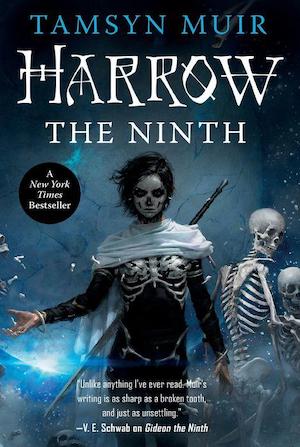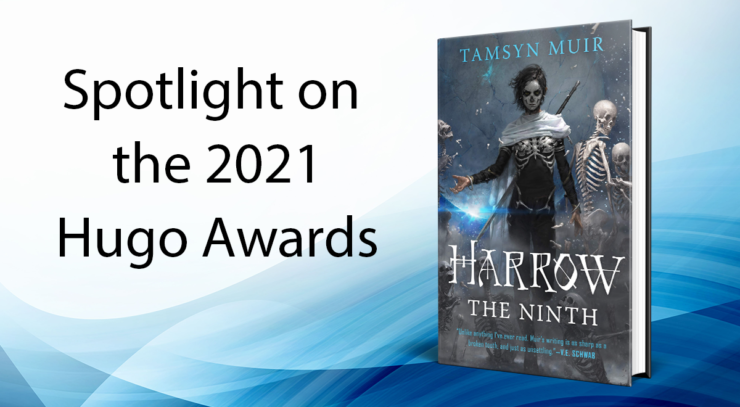In the lead-up to the 2021 Hugo Awards, we’re taking time to appreciate this year’s best novel Finalists, and what makes each of them great.
Gideon the Ninth waltzed up to the doors of reader expectation, planted plastic explosives around the frames while whistling a jaunty tune, and purposefully walked away in slow-motion, aviators glinting, and blew it all to hell. In a year of incredible genre fiction, Gideon the Ninth spread like wildfire, catching and sparking at every reader who picked it up and challenged them to a sword fight with one arm behind their back. Tamsyn Muir’s star ascended at a rocketing pace and the pressure of what Harrow the Ninth would be continued to grow and grow and grow. And upon release, much like Gideon, it wasn’t what anyone was expecting.
Note: This post contains spoilers.
In Gideon the Ninth, Harrowhark Nonagesimus, the Reverend Daughter of the Ninth House, had been a prickly, irritable, frustrating, cold, calculating, hurtful bully, who had an aura of pain and darkness that said, “Do not perceive me or I will turn you into mulch.” While we were only ever seeing her from the tinted lenses of Gideon—irreverent of the Reverend Daughter, crass, crude, with barely a thimble of trust between them–and we also got to see those lenses begin to lower as Gideon progressed. And finally, crumble, as Gideon went the way of dutiful cavaliers for their necromancers and impaled herself, giving Harrow the chance to begin the Lyctoral process and save them all from the vengeance of Cytherea the First. Readers, heartbroken, were ready to begin Harrow the Ninth seeing the Reverend Daughter coming into her own as a Lyctor for God, I mean the Emperor, I mean, John.
Muir said, “Nah.”
Red flags sprung up faster than a bad first date: The Emperor is going to die? Why can’t Harrow do what other Lyctors can? What the hell is a Resurrection Beast? Why is another Lyctor trying to murder Harrow? What do you mean Harrow can’t remember who Gideon is? And why in the Nine Houses are her memories of book one different? With all these questions and more, Muir began Harrow the Ninth, a book obsessed with memory, trauma, grief, pain, and mystery, and especially the way all these potent ingredients can meld and blend and fuse together in the shadow of a massive traumatic event.
Not one to rest on her laurels, Muir also maintained full-speed on exploring the dense lore and worldbuilding of The Locked Tomb series, introducing us to the remaining Saints of the Emperor, the droll Augustine, the caustic Mercymorn, the murderous Ortus, all while filling us in on the first few details of The Resurrection, the planetary ghosts that sprung up in the wake of such a traumatic event, John’s plans, the revolutionary group known as the Blood of Eden, and so much more, all the while Harrow struggled to understand what’s happening to her. All of this combined with Muir’s delight at meme culture and fanfic, her love of intricate and thorny relationships both queer and familial, and setting herself her own deadline with the impending death of God, Harrow the Ninth was a sequel seemingly too stuffed to stand.
Buy the Book


Harrow the Ninth
And yet, Harrow stood on its own and proudly, engaging a myriad of readers desperate to know more in an engrossing and enthralling series, happy to dive deep into the puzzle box that Muir handed them. Except unlike Gideon, where the puzzle box was external, the shifting landscape of Harrow was internal, as readers were tasked with solving any number of mysteries off the page. If Gideon was the necromantic, planet-wide escape room, then Harrow is the escape room of the heart and soul.
As the shape of the story becomes more and more clear, as the notes Harrow has left for herself become more understandable, as the memories of her the first book start to show their fraying edges, as readers begin to glean the shapes and pathways of the characters around her, Harrow the Ninth blossoms open into a story of surviving trauma, and the pain a person will choose to go through to achieve their ends. Sometimes those ends are the massacre of God and all that he built in the Resurrection. Sometimes those ends are hanging on, so desperately, to that which you fear to lose, that you’d rather forget they existed at all than know you’ve lost them.
Harrow the Ninth is a beautiful, heartbreaking story of trauma, reclamation, recovery, and pain, told through a queer lens as our Reverend Daughter comes to terms with what it really means to live forever if you can’t live with the one you love. As she passes through the various orbits of others pain and trauma, Muir showcases what happens when you don’t address it, and what can happen when your love for someone is twisted over centuries of refusing to heal. And in some cases, being so out of touch, you can’t even see it. It’s a testament to Muir’s skill as a writer that this deep emotional work happens in and around several planet-sized revenants coming to hunt God, a merciless golden-armed Lyctor flirting with our heroine with uncomfortable results, the most cursed bowl of soup in the universe, bringing a gun to a poetry fight, God has a threesome at some point and then dies, and the single greatest and damned Dad joke I have ever seen in modern science fiction.
The puzzle box continues as Harrow ends on yet another mystery, one that will be unraveled in the upcoming Nona the Ninth. But as seen in Harrow the Ninth, the mystery is the point, the joy, the drive to figure out what’s happening, and the pure satisfaction of solving it, and seeing what lies inside. I look forward to rereading Harrow again and again and reveling in Muir’s confident voice, assured narrative, and knowing just a bit more each time about how the puzzle resolves.
Martin Cahill is a writer living in Queens who works as the Marketing and Publicity Manager for Erewhon Books. He has fiction work forthcoming in 2021 at Serial Box, as well as Beneath Ceaseless Skies and Fireside Fiction. Martin has also written book reviews and essays for Book Riot, Strange Horizons, and the Barnes and Noble SF&F Blog. Follow him online at @mcflycahill90 and his new Substack newsletter, Weathervane, for thoughts on books, gaming, and other wonderfully nerdy whatnots.










